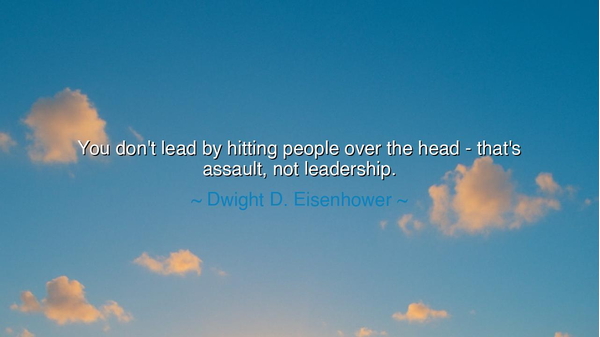
You don't lead by hitting people over the head - that's assault






Dwight D. Eisenhower, a general who bore the weight of nations in the crucible of war, uttered these words with the clarity of one who had seen the difference between true command and hollow force. “You don’t lead by hitting people over the head—that’s assault, not leadership.” Here, he revealed a truth as old as civilization: leadership is not brute domination, not the loud cry of authority imposed, but the gentle strength that inspires others to follow willingly. For the hand that strikes may compel obedience, but it cannot win the heart; and without the heart, no people can truly be led.
In the style of the ancients, we must see this not only as a lesson for rulers and generals, but as wisdom for all who guide others. Consider the shepherd who drives his flock with whips and sticks; the animals scatter, fearful, restless, never trusting. But the shepherd who walks ahead, calling them with a calm voice, finds his flock following faithfully. So too with human beings: to strike, to coerce, to intimidate, is to sow fear; to guide, to inspire, to encourage, is to plant loyalty that endures. Eisenhower, who commanded vast armies across the battlefields of Europe, knew this with the certainty of one who had tested it under fire.
Think of the story of Alexander the Great and his soldiers crossing the Gedrosian Desert. Exhausted and near death from thirst, his men watched as a helmet full of water was brought to him. He did not drink it alone; instead, he poured the precious water into the sand so that all could see he would not claim what they could not share. In that moment, without words, he led—not by striking or demanding, but by example. His men rose in spirit and followed him through the barren land. This is the difference between assault and leadership: one enforces obedience with fear, the other inspires devotion through sacrifice.
Eisenhower himself, during the Second World War, was not known for ferocious speeches or threats. He led with calm resolve, bringing together fractious allies—Americans, British, Canadians, and many more—who might otherwise have quarreled endlessly. He knew that to lead was to unite, to balance egos, to encourage cooperation. Had he tried to dominate them with forceful arrogance, the alliance would have fractured. Instead, through patience and persuasion, he became the binding thread of victory. This, too, is the living spirit of his words.
What, then, is the meaning for us today? It is this: wherever you stand—whether as a parent guiding a child, a teacher guiding students, a worker guiding peers—know that your strength lies not in your ability to coerce, but in your ability to inspire. To shout, to strike, to impose, may win short victories, but they breed resentment. To listen, to exemplify, to lift others up—this builds bonds that endure storms. True leadership is not conquest, but fellowship.
And so, let us resolve to abandon the illusion that force makes us strong. Instead, let us practice the harder, nobler path of patience, respect, and example. When anger rises and we are tempted to “hit over the head,” let us pause and ask: What would inspire instead? What would guide without violence? By doing so, we choose the way of the wise rather than the way of the tyrant.
Practical action lies before us: speak to others as you would wish to be spoken to; show the example you long to see; take responsibility not only for your own success but for the growth of those who walk with you. In this way, you will lead without striking, command without coercion, and earn loyalty without demand.
Thus, children of the future, remember Eisenhower’s lesson: force breeds fear, but leadership breeds trust. Walk, then, not as a tyrant with a raised hand, but as a guide with a steady heart. For the one who leads with wisdom does not leave behind scars of resentment, but legacies of honor that endure through generations.






AAdministratorAdministrator
Welcome, honored guests. Please leave a comment, we will respond soon